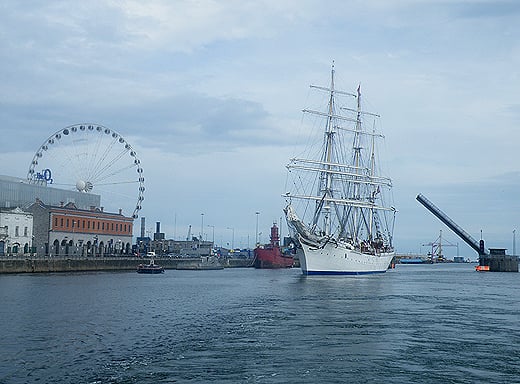The arrival of the largest and oldest Norwegian tallship the barque S/S Statsraad Lehmkuhl into Dublin Port yesterday made for an impressive sight, even without her sails set, writes Jehan Ashmore.
At nearly a century-old the square-rigged ship eased her way through the East-Link toll bridge where she proceeded to berth at Sir John Rogersons Quay, where she will be open to the public today between 12:00 – 16:30 and tomorrow,Saturday the 20th August from 10:00 –12:00. Her berth is downriver of the Samuel Beckett swing-bridge and the nearest DART stations are at Grand Canal Dock and Pearse St.
Statsraad Lehmkuhl is 321-feet long and the barque is also one of the largest three-masted sailing ships in the world. The height from the water-line to the top of the mainmast is 240-feet and in total she carries 22 sails which cover an area of over 2,000 square metres. Under canvass she can achieve 18 knots or when under motor-power her 1,125hp diesel engine manages 11 knots.
As reported on Afloat.ie the steel-hulled barque departed her homeport of Bergen last week on a voyage across the North Sea to include a call to Stornoway on the Isle of Lewis. She was built in 1914 originally for the German Merchant Marine and at nearly a century-old she has had a colourful career having changed hands between Germany and Britain during both World Wars.
Since 1978 she has been with her current operators the Statsraad Lehmkuhl Foundation, based in the Nordic's country's second largest city. For further information about the 1,516-tonnes vessel specifications click
HERE and interior illustration of deck layout click
HERE.
Her arrival marks nearly a year in advance to Dublin City welcoming the return of the Tall Ships Races, presented by Szczecin and organised by Sail Training International. The capital last hosted the event in 1998 and next year up to 100 tall ships are to sail into the capital which will be the final host port for four days between 23rd-26th August 2012.

Tall Ship S/S Statsraad Lehmkuh in Dublin Bay yesterday. Images: Iain White
The celebration of sail is expected to draw entrants from as far away as Chile, Mexico, Argentina, USA and European and Baltic countries including Italy and Norway will chart their course to Dublin. It is hoped that the event will attract over a million visitors to the city, topping the 500,000 spectators who thronged the Waterford quays during this year's tall ship race gathering.

Photo: Jehan Ashmore


































































